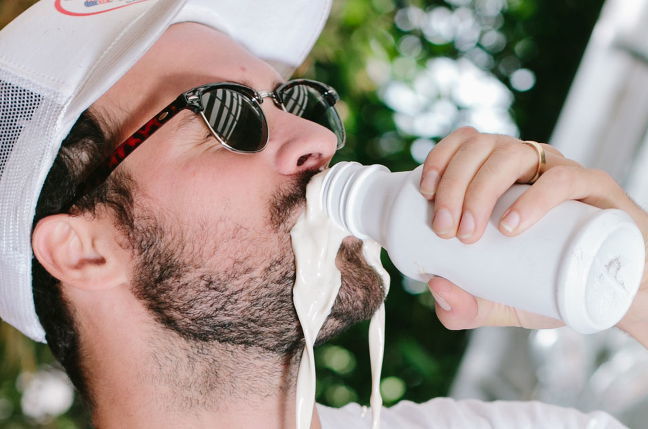
Soylent, the startup dedicated to conquering the universally hated ritual of eating food, now offers a version of its protein-rich nutrient gloop in ready-to-drink bottles.
Previous versions of Soylent arrived as powders that you mix with water. That takes time, much like it does to sear a cut of filet mignon lightly on both sides and arrange it on a plate with some potatoes and steamed vegetables.
This new version, dubbed Soylent 2.0 – unlike salads, which do not come with version numbers because they are a thing of the past – comes premixed in 14 ounce bottles, each of which provides 400 calories of nutrition.
"A major step forward, Soylent 2.0 frees customers from crowded lunch lines at fast food restaurants and ends feelings of mid-morning hunger after inadequate breakfasts," the company said in a statement, presumably after sweeping a plate of eggs Benedict into the trash.
Soylent is not in fact people. The company has not obtained a license from the US Food and Drug Administration to produce its alt-food slurry from composted human cadavers.
Instead, Soylent is composed of a mix of soy protein, carbohydrates, and other nutrient-rich ingredients, "with half of its fat energy coming from farm-free, algae sources" – as distinct from a succulent roast chicken, which derives the majority of its fat energy from roast chicken.
Unlike crispy bacon, Soylent 2.0 is available on a subscription basis. Where slices of French baguette smeared with brie cheese would ordinarily need to be created individually and on demand, Soylent will arrive at your doorstep prepackaged and ready to consume, with no action to be taken on your part but to open a bottle and slurp the nourishing goo inside.
Much like fettuccine carbonara festooned with shreds of fresh grated parmesan cheese and paired with a cup of minestrone soup, Soylent 2.0 will sustain your life, allowing you to move through the world without embarrassing episodes of famine-related unconsciousness.
Unlike a fresh trout slathered with butter and baked in parchment paper with mushrooms and shallots, however, a meal of Soylent 2.0 requires no heat and each bottle can remain unrefrigerated for up to one year.
"Avoiding refrigeration and spoilage further reduces the resource consumption of Soylent compared to other dietary staples," the company explained, possibly in a reference to chicken tikka masala with saffron rice, which will spoil if not consumed in one sitting or refrigerated.
Other dietary staples have historically been problematic. For example, Spanish paella, despite producing a mouth-watering aroma that wafts across the room when steaming hot, contains shellfish, to which many people are allergic. Soylent does not. Similarly, while a lentil stew made with onion, garlic, tomatoes, spinach, mint, parsley, and potatoes might be a valid form of vegetarian nutrition, it still requires chewing. Soylent has solved this problem.
NAPL?

Reminds me of the bucket of goop Frito always ate in Idiocracy.

Soylent Green ???
Heck! I’d at least try it. I eat Duck’s feet and Sea Cucumber.
“...the universally hated ritual of eating food...”
And what else would one wish to eat?
Reading that article made my mouth water.
For all the “unlike Soylent” cuisine!
Let me see: Each bottle of Soylent, at 400 calories, contains:
Soy protein—forget about avoiding allergens, as soy is allergenic. And to get soy, you certainly have to convert large areas of land to agriculture.
Algal oil—we’ve come full circle now. From converting food (corn) to fuel for our cars, now a company is converting biofuel (algae) to food.
Isomaltulose from beets—again, requiring large areas of land for agriculture, plus wasting all of the other components of the beets, like fiber and tasty redness. Speaking of which, where is the fiber in Soylent?
Vitamins & minerals—each bottle contains 1/5 of the RDA of essential micronutrients. So, to get the full RDA would require drinking 5 bottles—which, for me, is about 500 calories over my daily needs. Furthermore, where do those micronutrients come from? I bet they are extracted from food—again, a huge waste of food and excess use of agricultural lands.
Environmentally, this stuff is clearly not very good for the environment. And it probably would make for a very unhealthy diet if consumed exclusively. It’s major value would be as something to tide one over if one really did not have access to real food for some reason.